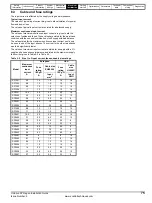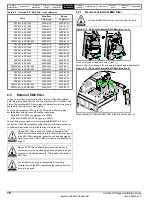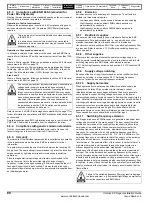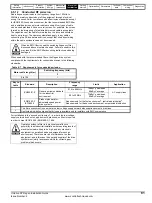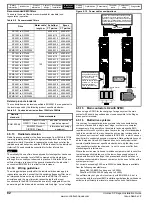
Safety
Information
Introduction
Product
information
System
design
Mechanical
installation
Electrical
installation
Getting
started
Optimisation
Parameters
Technical
data
Component
sizing
Diagnostics
Unidrive SP Regen Installation Guide
89
Issue Number: 2 www.controltechniques.com
8 Optimisation
The following section covers optimisation of the regen system which can
be carried out by the user.
The Regen drive uses a DC bus voltage controller with inner current
controllers as shown in Figure 8-1
:
Figure 8-1 Regen controllers
The gains of the voltage and current controllers affect the stability of the
Regen system, with incorrect settings resulting in over-voltage or over-
current trips.
8.1 Power feed-forward compensation
(Pr 3.10)
Power feed-forward compensation can be used to reduce the transient
DC bus voltages produced when a fast load transient occurs on the
motoring drives connected to the Regen drive.
100.0% power feed-forward is equivalent to an active current of:
Drive rated current / 0.45 (i.e. over current trip level)
and a Vac terminal peak phase voltage equal to:
DC_VOLTAGE_MAX / 2
This scaling is the same as the power output from Pr
5.03
when high-
speed output mode is used (Refer to section 9.7
).
Therefore an analogue output from the drive supplying the load, and
analogue input 2 or 3 of the drive acting as the supply Regen drive can
be connected together to give power feed-forward compensation without
further scaling if the two drives are of equal rating.
If the ratings are different the analogue input scaling must be used to
give the correct power feed-forward, where the scaling is given by
(load
drive)
drive rated current /
(Regen drive)
drive rated current.
Figure 8-2 shows the Regen drives analogue inputs and motoring drives
analogue outputs which can be used to pass Pr
5.03
(motoring drive
output power) to the Regen drive which is then used for the power
feedforward.
Only one analogue output from the motoring drive and one analogue input
to the Regen drive is required to configure the power feedforward term.
Figure 8-2 Power Feedforward configurations
8.2 Current loop gains
The defaults current loop gains (Kp, Pr
4.13
and Ki, Pr
4.14
) are suitable
for most standard regen systems. However if the input inductance is
significantly higher the proportional gain may need to be adjusted as
described following.
The most critical parameter for stability is the current controller
proportional gain
, Pr
4.13
. The required value for this is dependent
upon the Regen drives input inductance. If the inductance of the supply
is a significant proportion of the recommended regen inductor
i.e. 60/I
DR
mH per phase,
Where:
I
DR
is the drive rated current
then the proportional gain may need to be increased.
The supply inductance is likely to be negligible compared to the regen
inductor value with small drives, but is likely to be significant with larger
drives. The proportional gain, Pr
4.13
should be adjusted as described
following using the total inductance per phase.
The
proportional gain
, Pr
4.13
can be set by the user so that
Pr
4.13
= Kp = (L / T) x (I
fs
/ V
fs
) x (256 / 5)
Where:
T
is the sample time of the current controllers. The drive compensates
for any change of sample time, and so it should be assumed that the
sample time is equivalent to the lowest sample rate of 167
µ
s.
Feature
Detail
Power feed-forward
Power feed-forward can be used to reduce fast transient DC Bus voltage effects produced by transient load conditions on
motoring drives mainly in Dynamic applications
where spurious over-voltage and/or over-current trips are experienced.
Voltage controller gain
The voltage controller gain can be implemented to overcome instability in the DC voltage on the common DC Bus in the
following conditions,
•
A brake resistor replacement system where the ratio between regen brake drive and motoring drive(s) DC Bus
capacitance is large
•
With multiple motoring drive(s) where the ratio between the regen drive(s) and motor drive(s) DC Bus capacitance is
large.
Ensure the voltage controller gain is not increased to high as this can also introduce excessive ripple and instability on
the DC Bus.
Current loop gains
The current loop gains can be optimised to overcome spurious over-current trips during either synchronisation to the
power supply, or during operation.
The default gain settings are sufficient for most applications however these can be modified with the proportional (Kp)
being the most critical for stability.
Power factor correction
This does not optimize the regen system but improves the power factor of the supply that is connected to the regen
system.
•
Will introduce cost saving (electricity bill), compensate for inductive loads on the same supply, and overcome voltage
drops due to “soft supplies”.
•
A separate power factor correction unit may not be required.
•
The symmetrical current limit must be below its maximum in order for power factor correction to work (therefore may
be limited due to regen drive size).
Voltage
controller
Current
controllers
-
-
DC bus
voltage
feedback
Current
feedback
Pr
DC
bus voltage
set point
3.05
Analogue input 2
7.14
7.12
Destination Pr
= 3.10
Scaling Pr
Analogue input 3
7.18
7.16
Destination Pr
= 3.10
Scaling Pr
Regen drive
Analogue I/P 2
Pr set-up
Analogue I/P 3
0V common
Pr set-up
Analogue O/P 1
Analogue O/P 2
0V common
Motoring drive
Analogue output 1
7.19
7.21
Source Pr
=
5.03
Mode Pr
=
H.SPd
Analogue output 2
7.22
7.24
Source Pr
= 5.03
Mode Pr
=
H.SPd
7
8
11
9
10
11
Содержание SP1201
Страница 219: ......
Страница 220: ...0471 0029 02 ...

